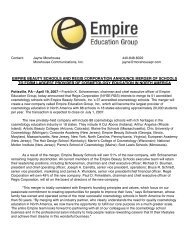KENTUCKY CATALOG 2012-2013 - Empire Beauty School
KENTUCKY CATALOG 2012-2013 - Empire Beauty School
KENTUCKY CATALOG 2012-2013 - Empire Beauty School
You also want an ePaper? Increase the reach of your titles
YUMPU automatically turns print PDFs into web optimized ePapers that Google loves.
14<br />
SatiSFactoRY acaDEMic PRoGRESS PolicY (SaP)<br />
Grading Procedure<br />
theory ( lessons in review, self- tests, quizzes, tests and examinations)<br />
Practical work (on mannequins)<br />
Student Salon/ clinic (work on Customers and Models)<br />
Are graded on the following criteria:<br />
Grading Scale<br />
100% Outstanding A+<br />
92%-99% Above Average A<br />
85%-91% Average B<br />
79%-84% Average C<br />
75% -78% Below Average D<br />
Below 75% Failure F<br />
TUITIon &<br />
fInanCIal InfoRMaTIon<br />
notE: Individual lessons and examinations can be retaken if the grade<br />
falls below 75% In this case the second score will be averaged with the fi rst<br />
score. In the case of a failed curriculum, the second grade will be the grade<br />
of record.<br />
Standards of Satisfactory Progress<br />
SAP is a requirement for all students enrolled in the Cosmetology-<br />
Hairstyling, Nail Technology, Esthetics, and Cosmetology Educator Training<br />
programs. Written notice of SAP standing will be provided to students<br />
at the time of evaluation. Copies of evaluations, as well as appeal results,<br />
will be kept in the student’s fi le. Students that withdraw and re-enroll will<br />
return under the same SAP status as when they left, regardless of how long<br />
he/she has been out.<br />
In order to be meeting SAP students must maintain specifi ed grade<br />
levels. They must also proceed through the course at a pace leading<br />
to completion in the maximum time frame as defi ned below*. SAP is<br />
evaluated at the scheduled mid-point of a program for programs of one<br />
academic year or less. Evaluations are at the scheduled end of each<br />
payment period (every 450 scheduled clock hours or 15 scheduled credits)<br />
per academic year for all other programs. If a subsequent academic<br />
year is more than 450 hours or 15 credits and less than 900 hours or 30<br />
credits, payment periods are equal to one half of that academic year. If a<br />
subsequent academic year is 450 hours or less then it is considered one<br />
payment period. SAP evaluations are always concurrent with the scheduled<br />
end of a payment period.<br />
In clock hour programs an academic year consists of 900 clock hours over<br />
a period of not less than 26 weeks. In credit hours or credit programs, an<br />
academic year is the number of weeks it takes for a student to attempt<br />
completion of 30 credits. The number of weeks varies according to<br />
schedule of attendance but must be at least 30 weeks.<br />
In clock hour programs students who do not meet academic requirements<br />
(75% cumulative grade average) or attendance requirements (75%<br />
cumulative attendance average) as of the evaluation will be considered not<br />
making satisfactory progress. They may lose eligibility for fi nancial aid from<br />
Title IV HEA program funds, and may be subject to termination from the<br />
program.<br />
In programs measured in credits students who do not meet the academic<br />
(75% cumulative grade average) or cumulative completion of at least 75%<br />
of the credits attempted as of the evaluation will be considered not making<br />
SAP. They may lose eligibility for fi nancial aid from Title IV HEA program<br />
funds, and may be subject to termination from the program.<br />
<strong>School</strong> holidays are considered in the calculation of cumulative attendance.<br />
Course incompletes and noncredit remedial courses are not applicable<br />
and have no eff ect on SAP standards. Clock hours or credits accepted from<br />
another institution toward the student’s educational program are counted<br />
as attempted and completed.<br />
Financial Aid Warning Status<br />
Students who are evaluated at the end of a payment period and fail to<br />
meet SAP are automatically placed on fi nancial aid warning status. They<br />
may continue to receive assistance under the Title IV HEA programs for one<br />
payment period. Financial aid warning status may be assigned without an<br />
appeal or other action by the student. If the student does not achieve SAP<br />
by the end of that payment period eligibility for Title IV program funds will<br />
cease. A student may appeal and if successful may be placed on Financial<br />
Aid Probation.<br />
Financial Aid Probation<br />
The institution may place a student on fi nancial aid probation and may<br />
disburse Title IV, HEA program funds for the subsequent payment period.<br />
All the following conditions must be met,<br />
a. The student must appeal the determination that they are not making<br />
satisfactory progress.<br />
b. The institution must determine that the student should be able to make<br />
satisfactory progress during the subsequent payment period and meet the<br />
institution’s SAP standards at the end of that payment period.
















